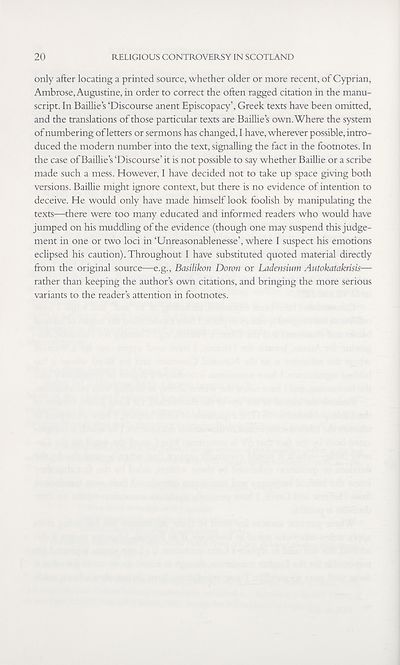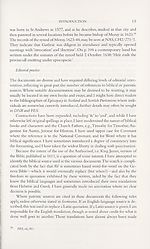Series 5 > Religious Controversy in Scotland 1625-1639
(35) Page 20
Download files
Complete book:
Individual page:
Thumbnail gallery: Grid view | List view

20
RELIGIOUS CONTROVERSY IN SCOTLAND
only after locating a printed source, whether older or more recent, of Cyprian,
Ambrose, Augustine, in order to correct the often ragged citation in the manu¬
script. In Baillie s ‘Discourse anent Episcopacy’, Greek texts have been omitted,
and the translations of those particular texts are Baillie’s own. Where the system
of numbering of letters or sermons has changed, I have, wherever possible, intro¬
duced the modern number into the text, signalling the fact in the footnotes. In
the case of Baillie’s ‘Discourse’ it is not possible to say whether Baillie or a scribe
made such a mess. However, I have decided not to take up space giving both
versions. Baillie might ignore context, but there is no evidence of intention to
deceive. He would only have made himself look foolish by manipulating the
texts—there were too many educated and informed readers who would have
jumped on his muddling of the evidence (though one may suspend this judge¬
ment in one or two loci in ‘Unreasonablenesse’, where I suspect his emotions
eclipsed his caution).Throughout I have substituted quoted material directly
from the original source—e.g., Basilikon Down or Ladensium Autokatakrisis—
rather than keeping the author’s own citations, and bringing the more serious
variants to the reader’s attention in footnotes.
RELIGIOUS CONTROVERSY IN SCOTLAND
only after locating a printed source, whether older or more recent, of Cyprian,
Ambrose, Augustine, in order to correct the often ragged citation in the manu¬
script. In Baillie s ‘Discourse anent Episcopacy’, Greek texts have been omitted,
and the translations of those particular texts are Baillie’s own. Where the system
of numbering of letters or sermons has changed, I have, wherever possible, intro¬
duced the modern number into the text, signalling the fact in the footnotes. In
the case of Baillie’s ‘Discourse’ it is not possible to say whether Baillie or a scribe
made such a mess. However, I have decided not to take up space giving both
versions. Baillie might ignore context, but there is no evidence of intention to
deceive. He would only have made himself look foolish by manipulating the
texts—there were too many educated and informed readers who would have
jumped on his muddling of the evidence (though one may suspend this judge¬
ment in one or two loci in ‘Unreasonablenesse’, where I suspect his emotions
eclipsed his caution).Throughout I have substituted quoted material directly
from the original source—e.g., Basilikon Down or Ladensium Autokatakrisis—
rather than keeping the author’s own citations, and bringing the more serious
variants to the reader’s attention in footnotes.
Set display mode to:
![]() Universal Viewer |
Universal Viewer | ![]() Mirador |
Large image | Transcription
Mirador |
Large image | Transcription
Images and transcriptions on this page, including medium image downloads, may be used under the Creative Commons Attribution 4.0 International Licence unless otherwise stated. ![]()
| Scottish History Society volumes > Series 5 > Religious Controversy in Scotland 1625-1639 > (35) Page 20 |
|---|
| Permanent URL | https://digital.nls.uk/127328385 |
|---|
| Description | Over 180 volumes, published by the Scottish History Society, containing original sources on Scotland's history and people. With a wide range of subjects, the books collectively cover all periods from the 12th to 20th centuries, and reflect changing trends in Scottish history. Sources are accompanied by scholarly interpretation, references and bibliographies. Volumes are usually published annually, and more digitised volumes will be added as they become available. |
|---|


![[Page 21]Historie of Church and State](https://deriv.nls.uk/dcn4/1273/2839/127328399.4.jpg)